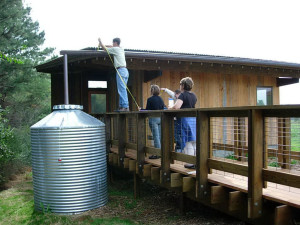Rainwater harvesting is an alternate water supply and stormwater management approach anyone can use. Rainwater harvesting captures, diverts, and stores rainwater for later use. You can collect rainwater in a large cistern, tank or barrel.
Implementing rainwater harvesting is beneficial because it reduces demand on existing water supply, and reduces run-off, erosion, and contamination of surface water. Rainwater harvesting can reduce the amount of drinking water used for landscape irrigation.
Rainwater can be used for nearly any purpose that requires water. These include landscape use, stormwater control, wildlife and livestock watering, in-home use, and fire protection. Rainwater harvesting systems can be connected to a low-volume irrigation system or water can be taken directly from a rain barrel to hand water your garden. Rainwater is good for plants because it is free of salts and other minerals that harm root growth.
A rainwater harvesting system can range in size and complexity. All systems have basics components, which include a catchment surface, conveyance system, storage, distribution, and treatment.
Benefits for the homeowner that installs a rainwater harvesting system are:
- Saves you money by reducing your water bills
- Reduces demand on municipal water supply
- Makes efficient use out of a valuable resource
- Reduces flooding, erosion, and the contamination of surface water with sediment, fertilizers and pesticides in rainfall runoff.
For more information please visit http://rainwaterharvesting.tamu.edu/

![rainbarrel[1]](https://watersmart.tamu.edu/files/2015/10/rainbarrel1-296x300.jpg)
